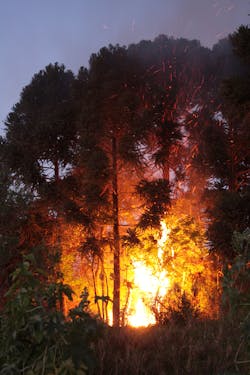Study Helps Water Utilities Prepare For, Respond to Wildfires
Water Research Foundation (WRF) completed a new study, “Effects of Wildfire on Drinking Water Utilities and Best Practices for Wildfire Risk Reduction and Mitigation” (project #4482).
The project compiles information gathered from a survey administered to drinking water utilities that experienced or are at risk of experiencing effects from wildfires; feedback gathered at an industry workshop convened in Denver that explored related topics in detail; and a review of related industry, academic and scientific literature. The project was jointly funded by WRF and the U.S. EPA’s Source Water Protection Program and Urban Waters Federal Partnership.
Wildfires can have significant impact on water utilities due to their potential widespread effect on source water quality and related treatment costs. From Jan. 1 through Nov. 8, 2013, 42,538 wildfires were reported in the U.S., burning almost 4.1 million acres of land. Burned areas are vulnerable to erosion and mud slides that can fill up sources of drinking water with ash, silt, fire retardant chemicals and contaminants, impacting both water quality and quantity.
Survey participants reported that collaboration with other drinking water systems, landowners, non-profit organizations, and local, state and federal government agencies was a critical aspect of effective wildfire mitigation. Collaboration helped survey respondents expand their knowledge base and leverage financial resources. Other best practices identified through the survey included:
- •Conducting strategic fuel reduction activities (such as burning, mechanical removal, grazing, etc.) in the watershed and areas immediately surrounding reservoirs.
- •Ensuring proper maintenance in and around the wells, pumps, and storage tanks.
- •Providing education in the form of staff training and awareness among rural residents.
- •Encouraging state or county ordinances to require fire safe activities around rural residences.
- •Creating a network of shaded fuel breaks at key locations to provide firefighters access to remote areas.
- •Developing partnerships and cooperation with other organizations to ensure upstream reservoirs have sediment containment capacity.
- •Being prepared in the event of a fire, including diversifying water intakes and establishing redundancy of treatment plants and raw water supplies.
- •Planning for wildfire appropriately, such as having a formal plan, implementing fuel hazard reduction, reducing wildfire severity, and developing pre-permitting sediment control structures downstream from high hazard areas.
- •Managing forest area in a way that will aid in delivering the highest water quality possible, such as considering the age and species composition of the forest.
Source: Water Research Foundation
